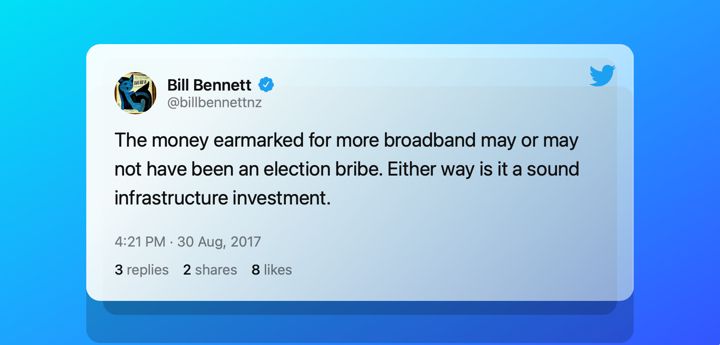Government broadband infrastructure investment fills gaps


Cynics were quick to label a generous government broadband funding announcement as pork barrel politics. There’s something in that. New Zealand is, after all, in the run up to what looks like a tightly fought election.
Yet anyone looking closely at the existing fibre network and the second phase of the Rural Broadband Initiative could have figured out that government needs to spend more to fill the remaining broadband gaps.
It was only a matter of time.
English, Bridges plug regional broadband holes
In the event, Prime Minister Bill English and Communications Minister Simon Bridges managed to find the extra government money needed to plug the holes. Sure, it is smart politics. It is also a smart communications strategy.
By the time the money is spent, New Zealand will have world-class broadband infrastructure. The cities were always going to get that. Now the regions will too. On paper New Zealand will have the world’s best rural broadband.
What’s more, we get that world-class network sooner. Five years from now the earth movers, fibre-laying gear, hard hats and high visibility jackets will be packed away. Just about everyone in New Zealand will be able to watch high-definition streaming video or quickly upload vast amounts of data to a cloud.
Fibre, copper, wireless network
Before this week the government committed about $2 billion to building a fibre network that would reach around 80 to 85 per cent of the population. Another 10 per cent or thereabouts would have either VDSL from fibre-fed cabinets or a fixed wireless connection of some description1.
This week’s spending brings the total spend up to around $2.5 billion. Between them the network builders2 will invest about twice as much again. That’s all private money. No-one uses the term in telecommunications; New Zealand’s new broadband network is a classic public-private partnership.
The cost to taxpayers is minimal. The $1.5 billion or thereabouts put aside for the first wave of Ultrafast Broadband was a soft loan. By 2025 the treasury will get that all back.
Old money
Much of the remaining billion dollars from government is either the same money recycled, or funds raised from levies imposed on telecommunications companies.
While taxpayers will ultimately cough up for this through higher service prices, it’s still clever accounting. And the cost per user is minimal. My back of an envelope calculation3puts it about 50 cents per month.
Compare this with the tens of billions Australia is spending on NBN. Many figures have been used over the years, around A$50 billion is the most common current estimate.
Australian’s will tell you it’s a bigger, more ambitious job reaching more people and spreading further. It’s true. Even so, it looks like the New Zealand people are getting a far better deal. Most of us also get better services than Australians too.
Copper network covered 99 per cent of New Zealand
At its peak, the old copper telephone network reached around 99 per cent of the population give or take. You can assume the last one per cent is beyond reach in practical terms.
Connecting the 75 per cent of the population living in cities and towns isn’t that hard. Laying fibre to the door for these people isn’t prohibitive.
The next ten per cent of the population is harder to reach, the cost per connection might be one and half to two times the cost of connecting the first 75 per cent of the population. It’s harder, takes longer and is more expensive. But it’s still doable.
Problems start with the remaining 15 per cent. In many cases it is cheaper to reach them with wireless services. Some of the last 15 per cent will be in communities which already have fibre connected to a local school. In others, there may be enough people in one spot to make fibre-fed cabinets and VDSL over copper a viable proposition.
Where fibre gives way to wireless
The cost per connection rises with each percentage point as you move from the 85 per cent mark to 99 per cent. At some point along this line the economics of fibre and copper give way, first to cellular fixed wireless and then to the more tailored, local approach used by wisps.
Fibre is the best way to get a broadband connection. Fibre-fed cabinets and VDSL over copper is second best so long as you are near enough to the cabinet. Today’s wireless technologies can often perform almost as well.
This plan leaves almost no-one behind and anyway, government will plug the few remaining gaps over time. New low earth orbit satellite technologies promise to perform as well as fixed wireless.
There’s a clear political slant to this week’s announcement. While the timing is deliberate, the decisions are money well spent. This is a sound infrastructure investment.
- Fixed wireless services from wireless internet service providers or wisps are not quite the same as the RBI fixed wireless broadband services delivered from cellphone towers. ↩︎
- Chorus, Northpower, Enable Networks, UFF, Spark, Vodafone, 2degrees and the wisps. ↩︎
- Total levy is $50 million a year. Divide that by the number of mobile, landline, fixed wireless and broadband accounts and then by 12. At a guess I’d say there are eight to ten million telecommunications accounts. ↩
Member discussion